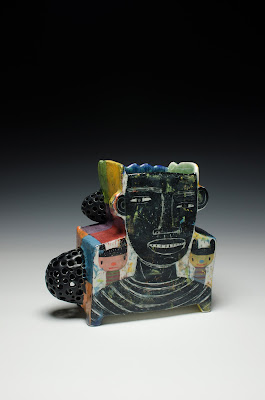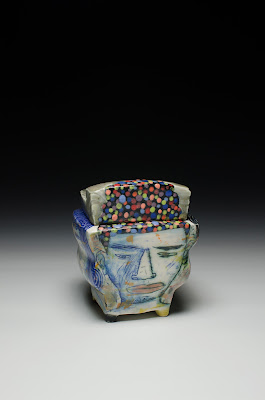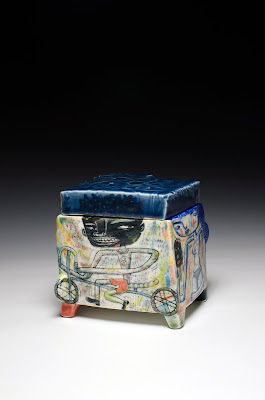Showcasing three solo exhibitions, Bridge 12 features the ceramic vessels patterned with quirky, figurative drawings by Kevin Snipes. The exhibition is open and free to the public November 9, 2012 through March 30, 2013.
Artist Kevin Snipes will visit SCC to teach Ceramics: Draw on Everything, Porcelain Tiles on Monday, January 21 from 10 am—4 pm. Students in this workshop will create two to three porcelain tiles, as they experiment with the ideas and techniques the artist introduces.
Snipe will also give a visual presentation on January 21st from 4:30-6pm that discusses how he is exploring new understandings of Blackness in his work. Afterwards, community members will share their own personal stories and relate these to issues presented in the artwork. This open dialogue is the latest program in SCC’s Faces Seen, Hearts Unknown series and is free to the public.
A version of the following text appeared in the publication for a
McKnight Ceramic Artist Fellowship Program exhibition at Northern Clay Center, Minneapolis, MN. We
are grateful to Northern Clay and The McKnight Foundation for granting
permission to reprint material from that essay.
“Every child is an artist,” Picasso
remarked, “The problem is how to remain one when we grow up.” From Picasso’s
time to the present-day, modern artists have often tried to match the
spontaneity and creativity of art made by children.
The ceramics of Kevin
Snipes feature drawings in a childlike style that is anything but childish.
Snipes uses his adult approach to drawing like a child to achieve some of the
simplicity and immediacy of children’s art, while also opening up other
expressive possibilities. Like two figures he admires, Lynda Barry and
Jean-Michel Basquiat, Snipes creates art that exploits the tension between
youthful forms and adult ideas.
 |
Bat Man, 2012
Porcelain, glaze, underglaze, oxide wash |
Snipes considers
himself primarily a storyteller, more than a potter or ceramist. Yet his
stories are not so much complete, self-contained narratives as vignettes—dramatic
moments expressed partly through words and partly through images, but always
with a mystery left unexplained, lingering “beneath the surface” as Snipes
likes to say. Since the images can occupy separate panels on flat-sided works
or flow around curved ones, Snipes is able to build complex relationships
between different elements in the overall design. He also likes to add
enigmatic, non-functional sculptural forms—small extensions somewhere between
colorful blossoms and disturbing growths. Drawn to a range of imagery, at times
from science and math books, he often introduces sharp juxtapositions: one side
of a vase may have a figure, another an abstract doodle, another a geometrical
diagram. The colors can be bright accents within the drawn outlines, or move
toward abstraction as they escape any neat integration with the figural
imagery.
 |
No Doubt (Back), 2012
Porcelain, glaze, underglaze, oxide wash |
 |
No Doubt (Back), 2012
Porcelain, glaze, underglaze, oxide wash |
Snipes has a
particular fascination with duality. He is not interested in some grand
metaphysical-cosmological yin/yang sort of thing. His double vision more often
involves the exploration of that old boy-girl, masculine-feminine, “Who can
explain love?” business. A pair of cups, or matched drawings on opposite sides
of a vase, enable Snipes to depict his concerns by fashioning two portraits, complementary
yet at odds. The modeled forms frequently support the drawn imagery. A male arm
will extend along the rim on one side, with a female arm on the other. The top
of a head may be cropped by the top edge of a mug, or extend upward so that the
hairdo doubles as a kiln chimney. Snipes deploys the figures on the surface of
the objects with an acute awareness, often making them appear cramped and
contorted. Beyond that physical tension, the images of men and women, sometimes
nude, sometimes gangly and awkward, bristle with psychological tension. A
female asks, “So?” A male replies, “Never mind.” Another female says, “Ain’t no
sunshine.” A couple on a bicycle built for two say, “Scram” and “Get lost!”
This world does not suggest a sweet sitcom. It is offbeat, edgy and even
naughty.
 |
Samo Samo 2012
Porcelain, glaze, underglaze, oxide wash |
Snipes is frequently
asked how he feels about being an African American artist who does not directly
address African American subjects in the usual identity politics fashion. His
reply has been steadfast: his treatment of duality and his interest in
psychological mystery and tension, when translated into the formal elements in
his work such as secret passages, indicate his larger concern with self-object
relationships and otherness, communication and miscommunication. The spaces in
his work serve as metaphorical allusions to the spaces between people, but also
as what he calls spaces of alchemy that indicate possibility.
 |
Wiggle, 2012
Porcelain, glaze, underglaze, oxide wash |
Snipes is still fascinated by the
spaces in conventional pottery, where the interiors can indicate not just
physical interiority, but psychological inwardness. Now, however, he is moving
in the direction of an architectural conception of space. Although Snipes has
favored a relatively small scale, he has also started to increase the size of
his work. “I think I need to work bigger, not big,” he says, adding, “The scale
I’ve been working in is really miniature.” Snipes has always regarded scale as
a conceptual element in his functional pottery because it establishes an
intimate relationship between his art and its audience. He is not abandoning
that idea now, but he does hope to introduce a slightly more assertive, public
presence for the images and objects. And now he has begun to introduce elements
that address race directly: first, black masks held by the figures, then black
faces and—a surreal, powerful touch—popsicles with cartoonish blackface
features.
 |
Yes, No, Maybe, 2012
Porcelain, glaze, underglaze, oxide wash |
Change is afoot, yet
one characteristic of the work has not changed. The simplicity of the imagery,
like the seeming children’s style, cannot conceal the grownup seriousness and
complexity of Snipes’ art.
—Robert Silberman
Robert Silberman, Associate Professor
of Art History at the University of
Minnesota in Minneapolis, writes
frequently about craft and contemporary art.He has published articles about Jun
Kaneko, Karen Karnes, Warren MacKenzie,Nora Naranjo-Morse, Ken Price and many
other artists.























